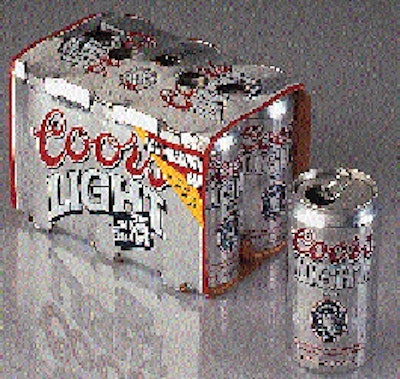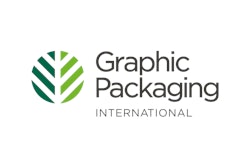(Richmond, VA). Now, Coors Brewing Co., Golden, CO, is teaming up with its joint venture partner, American National Can Co. (ANC) (Chicago, IL), to introduce its own version of the widemouth easy-opening end to give consumers "a more glass-like drinking experience." The 204 aluminum end is the new standard for all Coors Light cans. For now, Coors Light foil laminated paperboard carriers, produced by Graphic Packaging Corp. (Wayne, PA), carry a corner violator calling attention to the changed cans inside. With the number two and three U.S. breweries opening wide so consumers can have less restricted access to their suds, can Anheuser-Busch, number one in the market, be far behind? Probably not. Word around the beverage can industry is that AB's Metal Container Corp. (St. Louis, MO) is perfecting its own big mouth. Reynolds and ANC, meanwhile, have developed families of LOEs for use on teas, juices, still drinks and carbonated soft drinks. With everyone citing research showing strong consumer preference for the big mouths, and no one citing overly challenging technological hurdles in developing and producing the new ends, one wonders why this good idea didn't come along sooner? Painting a packaging picture by the numbers With the Pack Expo show just around the corner (November 17-21, McCormick Place, Chicago), the Packaging Machinery Manufacturers Institute (Arlington, VA) has issued its Second Annual Packaging Machinery Shipments and Outlook Study. It's the best of several recent studies and statistical reports being released by various organizations. This detailed report is well worth the $2귔 non-PMMI member price tag for market analysts and new product/package development specialists. Based on the input of both PMMI and non-PMMI packaging machinery manufacturers, it offers an interesting and insightful perspective on packaging trends as reflected in sales trends for 17 classes of packaging equipment. There is no hype here, only clear reporting. It notes, for instance, that while 1995 packaging machinery shipments rose 10.9% over the 1994 figure, reaching $3.82 billion, shipment growth is slowing and expected to average only 4.6% annually through 1998. Spending only a little time analyzing the numbers, you can rank packaging machinery categories and draw your own market conclusions. The top five packaging machinery categories, in terms of 1995 vs. 1994 sales growth rates, for instance, finds palletizing, depalletizing and pallet unitizing in first place. The next four categories are: * Case/tray forming/loading/sealing * Skin/blister packaging * Vertical form/fill/seal equipment * Liquid fillers The Dairy and Food Industries Supply Assn., Inc. (McLean, VA) includes some numbers on packaging equipment in its Annual Capital Equipment and Supplies Study. Released last month, it suggests that U.S. and Canadian dairies and juice processors will be increasing their packaging machinery expenditures by an average of 2.7%, spending, on average, $310굒 for packaging equipment. The equipment at the top of DFISA's top five packaging list (ranked by average expenditures) are: * Extended shelf life/aseptic fillers ($157군) * Gabletop carton fillers ($44군) *Case/carton forming, filling, sealing ($37귔) * Case handling equipment ($31꽤) * Palletizers/depalletizers ($26길) DFISA's study is available to non-members for $200. For $375, the Point-of-Purchase Advertising Institute (Englewood, NJ) will send you the Summary and Analysis report of its 1995 Consumer Buying Habits Study. There, you'll learn that fully 70% of the supermarket shopper's buying decisions are made in the store--a jump from 66% a decade ago. Among the food products most likely to be impulse buys: candy/gum, fresh sweet baked goods, pickles/olives/relish, salsa and dip and shelf-stable prepared foods. The power of packaging (and the point-of-sale promotion that may accompany it) comes across loud and clear in POPAI's data on package-stimulated impulse purchases which add, on average, 12% to the bill at checkout. Pieced together, these studies reflect a food processing industry intent on streamlining distribution costs, extending shelf life and appealing to consumers. Those consumers, unlike their counterparts of a generation or two ago, are less likely to be weekly shoppers working from lists on planned menus. Increasingly, they are grazers, stopping on the way home from work, looking for quick ideas to serve for supper. c



























